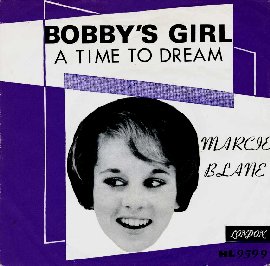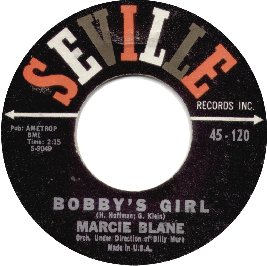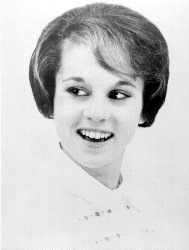
The month of December 1962 found the US airwaves filled with female teen idols. "All Alone Am I", lamented Brenda Lee, while Dee Dee Sharp urged everyone to "Ride", Mary Wells sang about her "Two Lovers" and Little Eva warned her rivals to "Keep Your Hands Off My Baby". Groups like the Crystals, the Orlons, the Exciters and the Cookies were selling like hotcakes too. Sitting pretty above them all in the record charts at the time was MARCIE BLANE, who wanted to be . . . BOBBY'S GIRL.
Prior to that moment, Marcie had lived the life of the archetypal American teenager. Real name MARCIA BLANK, she grew up in Brooklyn, New York with her parents Ernest and Muriel, older sister Janet, and younger brother and sister, Carl and Sandra. Marcie had music in her blood. Pa Blank earned his living as a professional musician and music teacher. He had been working as a pianist in the Catskills when he first met and fell in love with 16-year-old Muriel Shalit, whose parents would only consent to their daughter's marriage on the understanding that Ernest graduated from college first. Sure enough, after gaining a degree in music education at NYU, the couple were wed.
Marcie loved nothing better than to entertain her family and friends by singing her favourite folk songs, accompanying herself on piano and guitar. When the Blanks relocated to Queens, Long Island, she enlisted at Jamaica High and joined the school band on flute. She became captain of the cheerleaders, secretary of the dance corps and also played violin in the orchestra. Like many youngsters, come the summer, Marcie went away to camp, in her case Camp Diana in Glen Spey, New York, where she would frequently perform for the other kids, sometimes assisted by her friend Bruce Milner from the adjoining boys camp, Dalmaqua. By 1961 Marcie was secretary of Jamaica High School's senior class.
 |
 |
It was about the time of her graduation in June 1962, that Marcie was asked by a songwriter friend to record a demo of some of his compositions. "It wasn't supposed to lead to anything," she recalled many years later. "I was just doing someone a favour. I was only supposed to go in and cut the demo and leave." When Marv Holtzman, A & R man at Seville Records, heard the demo discs, it wasn't the songs that impressed him, but the singer. "The fellow at the record company liked me and offered me a contract. How could I say no to that? I don't think I ever gave it much thought. The first song they came up with was "Bobby's Girl". That was the first recording session." One minute she was schoolgirl Marcia Blank, the next she was Seville recording artist MARCIE BLANE, about to embark on a showbiz career. But for the time being, life went on as before, "I went away to camp that summer to be a counsellor. No one at school even knew I had recorded that."
Written by Hank Hoffman and Gary Klein, Marcie Blane's "Bobby's Girl" was soon on sale. With its spoken introduction and "You're not a kid anymore" backing refrain, the disc struck a chord with teenage Americans almost immediately, entering the charts in mid-October and rocketing into the Top 10 within a month. By December it was at #3 on the Billboard Hot 100, a position it maintained for four weeks. Only the 4 Seasons' "Big Girls Don't Cry" and Elvis Presley's "Return To Sender" held it from the top spot. Over on the Cash Box chart, "Bobby's Girl" was even bigger news, peaking at #2 during an impressive 19-week run, nine of those spent in the Top 10. The 18-year-old was the best-selling female singer in the land.
 |
 |
Marcie's debut was also successful all around the world, with the exception of the UK, where a cover version of the song by Susan Maughan stole her thunder. Meanwhile, the answer-record phenomenon was prevalent, with "Bobby's Girl" generating at least two examples, in the Sherry Sisters' "Stay Away From Bobby" and "She Wants To Be Bobby's Girl" by Dickey Lee, of "Patches" fame.
 |
 |
As was common practice back in the day, Seville Records rush-released Marcie's follow-up while "Bobby's Girl" was still on the charts, lest her fans forget her. Once again, the Hoffman/Klein team placed themselves inside the mind of a teenage girl, and came up with "What Does A Girl Do". When the song entered the Hot 100 in February, it must have seemed as if smash hit number two was about to happen, but it wasn't to be, and it stalled at a lowly #82, disappearing after just two weeks. "What Does A Girl Do" fared a little better on the Cash Box chart, rising to #68 and hanging on for an extra month. It seems the song's lyrics were deemed too risqué for radio play.
 |
 |
Overseas, American singers like Brenda Lee, Connie Francis and others were enjoying hits with recordings in the German language. Seville had Marcie test her linguistic skills too, with "What Does A Girl Do" emerging as "Wer Einmal A Gesagt", and its b-side, "How Can I Tell Him", as "So Ist Das Leben", strictly for the German market.
Seville kept Marcie's releases flowing thick and fast through 1963, but "Little Miss Fool", "You Gave My Number To Billy" and "Why Can't I Get A Guy" all failed to catch on, and her position as the nation's top-selling female singer was soon taken by Little Peggy March and Lesley Gore. But by now she had higher things than the fickleness of fans on her mind, having recently enrolled as a fulltime music major at Queens College, the alma mater of Paul Simon, Carole King and Marvin Hamlisch, to name just a few. Marcie did find time, though, to visit the UK, where she performed on TV's Thank Your Lucky Stars.
 |  |
Marcie's only release of 1964 was "Bobby Did", a song co-written by the then unknown Neil Diamond. 1965's "She'll Break The String" marked the end of her recording career. It transpires the whole experience had not been one Marcie had enjoyed. She loved music, and always had, but cared not for the record business. She had continued making records because she was contractually obliged to do so, but had elected against promoting them, focusing instead on her education and family life, the real world.
 |
 |
After graduating from Queens College, Marcie got married, had two children,
and went on to enjoy a whole new career working in education. She was
contacted during the course of research for this article, but politely
demurred a request for an official interview, preferring instead to maintain
her suburban privacy. "The music business was impossible for me to
deal with," Marcie revealed in a rare interview in 1988. "Everything
changed. I felt very isolated and very lonely. I decided not to continue.
I couldn't. It was too difficult. I didn't feel comfortable in front of
a lot of people, with everyone making a fuss. I didn't have the sense
of myself that I needed. It's taken all these years to be able to enjoy
what there was."
|
MARCIE BLANE U.S. DISCOGRAPHY |
||
|
Bobby's Girl / A Time To Dream |
Seville 120 |
1962 |
|
What Does A Girl Do? / How Can I Tell Him |
Seville 123 |
1963 |
|
Little Miss Fool / Ragtime Sound |
Seville 126 |
1963 |
You Gave My Number To Billy / Told You So |
Seville 128 |
1963 |
|
Why Can't I Get A Guy / Who's Going To Take My Daddy's Place |
Seville 130 |
1963 |
|
Bobby Did / After The Laughter |
Seville 133 |
1964 |
|
The Hurtin' Kind / She'll Break The String |
Seville 137 |
1965 |
 |
 |
(With thanks to Marcie Blane, Ian Slater, Eddy Smit, Sam Szczepanski and Malcolm Baumgart for their assistance and loan of memorabilia. Marcie Blane quotes taken from an interview with Bob Shannon and Jeff Tamarkin in Goldmine magazine, Issue 220, December 30, 1988.)
Marcie Blane CD: http://tinyurl.com/5tycm
PRESENTED BY THE SPECTROPOP TEAM